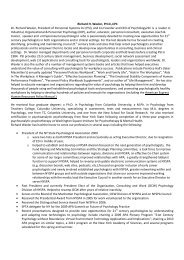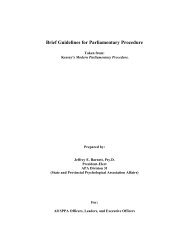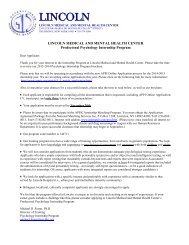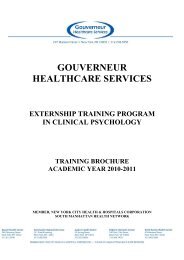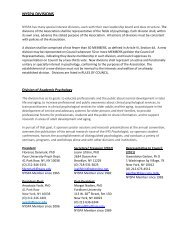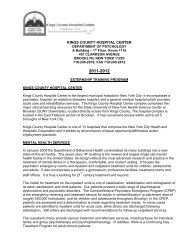2011 ⢠NYS Psychologist - New York State Psychological Association
2011 ⢠NYS Psychologist - New York State Psychological Association
2011 ⢠NYS Psychologist - New York State Psychological Association
You also want an ePaper? Increase the reach of your titles
YUMPU automatically turns print PDFs into web optimized ePapers that Google loves.
Women and Obesity: Biological / <strong>Psychological</strong> Factors and<br />
Bariatric Evaluations<br />
Artemis Pipinelli, PhD<br />
The Technical Career Institutes<br />
Abstract: This article will review Biological/ <strong>Psychological</strong> Factors<br />
on obesity for women and men and cover relevant health and<br />
medical conditions and bariatric evaluations. Obesity is one of the<br />
nation’s fastest growing and most troubling health problems according<br />
to world health organization. During the past 20 years<br />
there has been a dramatic increase in obesity in the United <strong>State</strong>s<br />
that has detrimental effects in the health both females and males.<br />
According to a million women study and other studies studying the<br />
relationship between obesity and health related factors, It was<br />
found that the is an association between obesity and diabetes 2<br />
mellitus, cancer, pregnancy complications, osteoarthritis, asthma,<br />
musculoskeletal pains and other health related problems.<br />
Keywords: Obesity, Bariatric Evaluations, Biological and <strong>Psychological</strong><br />
Factors<br />
Introduction<br />
According to the world health organization the prevalence of<br />
world obesity has doubled since 1980. In 2008 the estimation of<br />
people being overweight increased to 1.5 billion adults and among<br />
them there were 300 million obese women and 200 million obese<br />
men (World Health Organization, <strong>2011</strong>). Also, among nonpregnant<br />
women ages 20- 39, twenty-six percent were overweight<br />
and 29% were obese (WHO, <strong>2011</strong>).<br />
Women and Obesity<br />
When women and men are obese it means that they have<br />
high proportion of body fat, however overweight refers to the body<br />
weight; it does not mean body fat. Obesity is a condition in which<br />
the natural energy reserve, stored in the fatty tissue of humans<br />
and other mammals, is increased to a point where it is associated<br />
with certain health conditions or increased mortality (O’Brien et<br />
al., 2005).<br />
Health professionals use Body Mass Index (BMI), a mass<br />
measure, to classify a person’s weight as healthy, overweight, or<br />
obese. Body Mass index (BMI) describes body weight relative to<br />
height and is correlated with total body fat content in most adults.<br />
Metabolic syndrome (Grahovac et al., <strong>2011</strong>; Grundy et al., 2005;<br />
Lakka & Laaksonen, 2007; Lichtenstein et al., 2006) is a group of<br />
risk factors that can result in different health problems: stroke,<br />
type 2 diabetes and coronary heart disease. Women with excess<br />
body fat around the waist and abnormal cholesterol and sugar<br />
level, are increasing the risk of cardiovascular disease and type<br />
diabetes 2 mellitus. The Metabolic Syndrome has implications on<br />
abnormal glucose, metabolism, diabetes, dyslipidemia, and increased<br />
blood pressure all increased the risk of having heart disease<br />
and stroke (Kulie, Slattengren, Redmer, Counts, Eglash and<br />
Schrager, <strong>2011</strong>; Banks et al., 1999).<br />
The US Centers for Disease Control estimated that there<br />
were 112,000 excess deaths in the year 2000 from obesity-related<br />
diseases. Using Centers for Disease Control data, have predicted<br />
that female and male teens entering adulthood with a BMI more<br />
than 40 have their life expectancy reduced by up to 8 years for<br />
females and 13 years for males (O’Brien et al., 2005).<br />
Obesity is one of the nation’s fastest –growing and most troubling<br />
health problems. During the past 20 years there has been a<br />
dramatic increase in obesity in the United <strong>State</strong>s. Persons with a<br />
BMI more than 40 may be eligible for bariatric (weight loss) surgery.<br />
Banks et al., (1999) in the million women study the largest<br />
study of its kind that took place in Great Britain, tracked a million<br />
women between 50-64 years of age for five years. The study<br />
found that a high body mass was an indicator of all types of cancers.<br />
The risk of cancer was three fold with a 10 point increase in<br />
the body mass index. According to investigators 6000 women<br />
between 50 and 60 are diagnosed with cancer each year. Nearly<br />
50% of the cases pertaining to cancer of the womb and throat<br />
were found to be associated with obesity. The risk of ovarian cancer,<br />
kidney cancer, cancer of the pancreas, multiple myeloma and<br />
leukemia, increased with being obese, 45,037 new cancers were<br />
diagnosed and 17,203 women succumbed to the cancer during<br />
the period, the study revealed. In particular having excess abdominal<br />
fat, both intraperitoneal, intra-abdominal, as well as subcutaneous<br />
abdominal fat is associated with a metabolic constellation<br />
of abnormalities, which has been called the metabolic syndrome<br />
(WHO, <strong>2011</strong>). Kulie, Slattengren, Redmer, Counts, Eglash<br />
and Schrager (<strong>2011</strong>) reported that the relationship between obesity<br />
and related health factors such as diabetes 2 mellitus, pregnancy<br />
complications, osteoarthritis, asthma, skeletomuscular pains<br />
and cancer in women. Obese women with endometrial, ovarian,<br />
cervical and breast cancer have decrease survival because of<br />
later screening and lesser response to treatment (Kulie et al,<br />
<strong>2011</strong>). A recent investigation that was presented at the 79 th European<br />
Atherosclerosis Society (EAS) Congress shows obesity as<br />
an inflammatory biomarker and cause of heart disease. The results<br />
of this study show that with every 8.8 pound increase in BMI<br />
there was 52 percent increase in having ischemic heart disease<br />
(Nordestgaard, <strong>2011</strong>). Other related conditions that effect women’s<br />
health related to obesity are low back pain and osteoarthritis,<br />
infertility; including polycystic ovary syndrome relating to multiple<br />
endocrine mechanisms meaning increase in the circulating insulin<br />
levels (Kulie at al, <strong>2011</strong>). Also, among obese pregnant women<br />
there is the risk of Cesarean section, length of stay after delivery<br />
and use of services, fetal abnormalities increases as BMI increases.<br />
Maternal obesity is associated to shorter time in breastfeeding<br />
(Kulie et al, <strong>2011</strong>).<br />
Etiology of Obesity<br />
Genetic predisposition plays a role in gaining weight faster than<br />
other people. Weight gain and loss relates to the metabolic Rate,<br />
the rate that our body burns calories while at rest. When the metabolic<br />
rate of an individual is slow she/he gains weight easily. The<br />
pathogenesis of the metabolic syndrome involves the combination<br />
of genetic and environmental factors. The degree of genetic and<br />
environmental influences on the workings of the metabolic syn<br />
——————————————————————————<br />
Dr. Artemis Pipinelli, PhD, a Walden University graduate 2005, is an adjunct<br />
assistant professor for The Technical Career Institutes, College of<br />
<strong>New</strong> <strong>York</strong> teaching at the Human Services department. Prior she was<br />
teaching at Lehman College, Hunter and the CUNY system. She is an<br />
active member of <strong>NYS</strong>PA, past president of the Independent Practice<br />
Division, and member of APA serving in the Div 52 aging, membership<br />
and mentorship committee. She has presented numerous papers and<br />
presentations nationally and internationally.<br />
Page 5<br />
Vol. XXIII No. 2 • Fall <strong>2011</strong> • <strong>NYS</strong> <strong>Psychologist</strong>



